Comic Book Confidential: The Secret Society of Super Villains
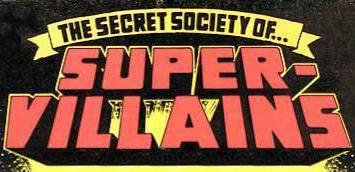 DC Comics took a lot of chances in the 1970’s in an effort to compete with their main rival Marvel and attract new comic book readers. One bold move was to give a dedicated title to a villain when they introduced The Joker series in 1975. Each issue pitted Batman’s chief nemesis against a variety of heroes and other villains while he was busy trying to commit crimes and relishing his insanity. The Clown Prince of Crime’s book only made it for nine issues but it provided the inspiration for another title that would be jam packed with criminals. As The Joker was winding down in 1976, DC debuted an intriguing new comic book for fans of characters on the wrong side of the law – The Secret Society of Super Villains.
DC Comics took a lot of chances in the 1970’s in an effort to compete with their main rival Marvel and attract new comic book readers. One bold move was to give a dedicated title to a villain when they introduced The Joker series in 1975. Each issue pitted Batman’s chief nemesis against a variety of heroes and other villains while he was busy trying to commit crimes and relishing his insanity. The Clown Prince of Crime’s book only made it for nine issues but it provided the inspiration for another title that would be jam packed with criminals. As The Joker was winding down in 1976, DC debuted an intriguing new comic book for fans of characters on the wrong side of the law – The Secret Society of Super Villains.
The basic concept of SSOV, creating a team out of disparate characters, was already old hat even where villains were concerned but most of these evil cadres were short lived and erratic. This book was intended to provide some stability for the super villain set while also featuring cameos by popular heroes and showcasing some characters that had been under utilized or had not seen the light of day in many years. It was a tall order by comic book standards and the myriad of moving parts ultimately proved to be an unwieldy machine but it was a fun ride while it lasted.
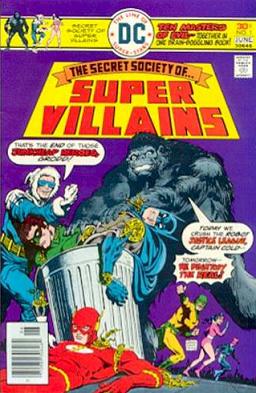
The premiere issue of Secret Society of Super Villains.
The first story arc ran from issues #1 through #5 and served to introduce the team. It was revealed a few issues in that the Society was formed by none other than Darkseid, the interplanetary conqueror and iron fisted ruler of the plant Apokolips, to aid him in the takeover of Earth. Using Manhunter, a morally ambiguous clone of the Golden Age superhero, as a front man, Darkseid recruited an odd bunch of villains heavily weighted towards the Flash’s Rouges Gallery including Gorilla Grodd, Captain Cold, Mirror Master, and Captain Boomerang. He also added the Earth-2 criminal The Wizard, Copperhead, Sinestro, and a new Star Sapphire and set them up in their own high tech headquarters called the Secret Citadel.
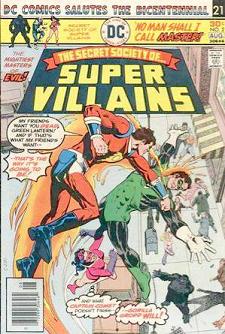
The forgotten hero Captain Comet makes a fiery return in issue #2.
In issue #2, Captain Comet, a forgotten hero from the early days of the Silver Age who had been MIA for many years, returned to Earth and was erroneously added to the rotten roster when he was mistaken for a criminal. This created a vendetta between Comet and the Society that would serve as a running theme for the rest of the series. Darkseid eventually stepped out of the shadows and divulged his ulterior motives which would ultimately make the group of egotistical villains his slaves if he succeeded. A full scale rebellion ensued with the Dark Lord of Apokolips suffering surprisingly heavy losses, including his apparent life, when the Manhunter clone turned out to be a human bomb and detonated himself in a boom tube with Darkseid when he tried to escape. Of course, like most characters in comic books, news of Darkseid’s death was greatly exaggerated and he would be back less than a year later as a lead character in the revived (Return of the) New Gods series with many other characters from Jack Kirby’s Fourth World.
Secret Society of Super Villains took a new direction with issue #6 when an obscure character called Funky Flashman, a public relations guru, stepped in to lead the group and turn the organization into a villains for hire company. The Society spent the next few issues on several less than successful jobs but did manage to recover a set of sorcery artifacts for an undisclosed client. This arc ended with a double coup. First, Gorilla Grodd attempted to form his own version of the Society to battle the Justice League which ended in the expected failure. Following the big ape’s imprisonment, the Wizard revealed himself as the mysterious benefactor who had been funding the group since Darkseid’s departure and used the artifacts he had them recover to increase his magical powers. He succeeded in ousting Flashman and reforming the fractured Society.
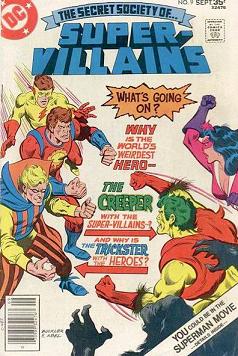
Issue #9 featured some new faces
During this time, the ranks of the Society consisted of most of the core group initially established plus a few transient members who lasted anywhere from one to several issues. The Flash foe known as the Trickster joined during this period but quickly betrayed the gang and flipped his loyalties frequently to suit his own agenda. Captain Comet was assisted in his pursuit by Kid Flash and several members of the Justice League while the strange hero, who seemed to be a villain, known as the Creeper infiltrated the Society and kept tabs on them.
With issue #11, the book began to pick up some much needed steam and finally gave the group of assembled anarchists a worthwhile reason to work together as a team. While one contingent continued the contract work on Earth-1, the Wizard lead another team to his home world of Earth-2 to destroy his old enemies the Justice Society of America and take over the planet! In the process, he accidentally transported his team to Earth-3, home of the Crime Syndicate who had not been heard from in over a decade, with Captain Comet hot on their heels. The Society managed to defeat the underpowered Syndicate and reach their original destination while Captain Comet was left behind to clean up their mess and deal with some seriously ticked off super villains! In issue #15, the Wizard finally put his plan into effect by defeating the Golden Age Atom and Doctor Midnight on Earth-2 while the Eath-1 group received a lucrative job offer. The Silver Ghost hired the Society to kill his arch enemies the Freedom Fighters and new members are added specialized to the mission. The issue ended with one faction of the Secret Society busy defeating the Justice Society and another poised to wipe out the Freedom Fighters! What a build up.
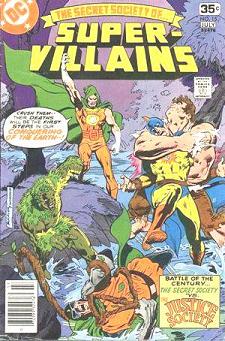
The exciting cover for issue #15 which turned out to be the final one.
Unfortunately loyal readers never got the opportunity to find out how this awesome premise played out as the SSOSV was canceled after that issue. It, like a large number of second tier DC comic books, fell victim to a major axe that was dropped at the time to eliminate any title that was not performing as anticipated and tighten up their product line. Many of these series already had stories completed when they were canceled so some were merged into omnibus books like Adventure Comics or World’s Finest while others became back up features in more successful titles. The Secret Society of Super Villains didn’t receive either option and the two issues that were on the literal drawing board never saw the light of day except for a handful of photocopies insightful DC employees cobbled together into two volumes of what they sarcastically termed the Cavalcade of Canceled Comics!
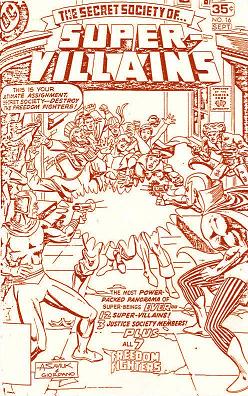
A tantalizing look at what might have been - the artwork for the cover of SSOSV #16.
Had the stories been allowed to reach their logical conclusions, Golden Age fans would have been in for a real treat. The Earth-2 group would have continued to systematically eliminate members of the Justice Society, with Mr. Terrific and Johnny Thunder next on the list, until the rest of the heroes got wise to the plot and used their combined force to boot the villains off the planet in defeat. In a similar fashion, the individual members of the Freedom Fighters are bested on Earth-1 until they can regroup and face the villains as a team. In the ensuing battle, both the Silver Ghost and FF’s own Firebrand would have died when the crimson crime fighter turned the Ghost’s own powers against him and perished in the process. Future issues would have divulged the origin of the mysterious new Star Sapphire, whose presence had gone unexplained since the series started, and provided some background information on Captain Comet including what he had been up to during his twenty years away from Earth.
Even though the title had ended, the Secret Society of Super Villains still continued to operate sporadically in the DC Universe, usually turning up with some new scheme to defeat the Justice League. Elements of this series would be used in the 80’s for the revamped Suicide Squad and lead to other combinations of crooks like Villains United and the Secret Six. While the SSOV was short changed at the newsstand and never allowed to develop to its full potential, it did fair better than many books of that era that were canceled even earlier in their runs or never got published at all. In the end, this mismatched mob of super powered criminals proved you can be good at being bad!
